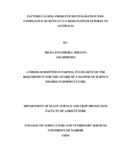| dc.description.abstract | Floriculture formsthe most significant part in the Kenyan Horticultural industry contributing
50% of the total value in the export market despite myriad challenges like multiple standards
and the ever changing market requirements.The objective of this study therefore was to
determine why Kenyan cut rose (Rosa hybrida L.) flowers exported to Australia continued to
fail the audit tests on devitalisation treatment requirement. The study involved a survey of the
accredited facilities, establishing the effectiveness of Roundup®; a.i 360g/l and Glyphogan®; a.i
480g/l glyphosate formulations at preventing propagationat different dipping levels and
assessing the effects of devitalisation on the cut flower vase life.
Nineteen out of the thirty eight AQIS accredited companies in Kenya were randomly selected
and surveyedto ascertain the level of awareness and implementation of the Australian
devitalisation protocol.For the propagation ability and vase life experiments, harvested export
quality cut rose flowers; cv. Bellerose, obtained from Sian Roses Flower Company were dipped
in glyphosate solutions ofRoundup®; a.i 360g/l and Glyphogan®; a.i 480g/lfollowing
procedures prescribed in the Australian pre-shipment devitalisation treatment guidelines. Tap
water acted as a control. For the propagation ability trial, 50 cm cut roses were dipped in the
preparedglyphosatesolutions at 15, 25, 35 or 45 cm depths. Data on percentage rooting, number
of roots, root length and percentage necrotic stems was collected after 26 days in the
propagation unit. To assess the effects of devitalisation on vase life, 40 cm cut roses were
dipped in the prepared glyphosate solutions up to 35 cm depth and thereafter held in holding
solution containing 2% sucrose and 1% sodium hypochlorite solution. Changes in fresh weight,
water balance, leaf abscission, chlorophyll content, and vase life were determined.
The survey results showedthat 100% of the company management and technical staff were
aware of the import requirements on devitalisation by Australia an indication of a good
communication link between the Kenya Plant Health Inspectorate Service (KEPHIS) and the
accredited companies with their staff. Ninety four percent of the companies carried out regular
trainings on devitalisation process. For the surveyed companies,39% preferred Roundup®; a.i
360g/l formulation.However, 33% of the companies were not preparing the devitalisation
solutionsas outlined in the protocol.In addition, only 22% of the companies kept complete
records that could aid in trace back in case of reports of non-compliance.
Devitalisation treatmentin the current study was found to inhibit rooting even at low dipping
depths of 15 cmbesides triggering necrosis of the stems. The treatment further increased leaf
abscission and wilting, reduced chlorophyll content and shortened vase lifeof cut roses by about
2 days while the petals remained intact. Glyphosatetreated cut roses also recorded a lower
negative water balance at -5.5g/day (Glyphogan®) and -3.5g/day (Roundup®) by the fourth day
compared to the control at -1g/day. In conclusion, the industry needs morecapacity building
and sensitization so as to own the process and uphold transparency.Considering the bio-security
concerns and the importance of this market,the observed negative effects of devitalisation on
the cut flower vase life should not compromise the adherence to the requirements. | |

